Editor’s note: This guide to Vasily Vereshchagin’s painting ‘Jaipur Procession’ was first published on The Heritage Lab—a wonderful resource of stories on cultural heritage, art, museums and lots more. You can find other essays on art and culture over at their website.
A Russian love letter to colonial India
Beauty comes in all shapes and sizes but whoever said ‘less is more’ has clearly not set their eyes on this painting! Measuring 196″ x 274″, this is Russian painter Vasily Vereshchagin’s pièce de résistance. The “Jaipur Procession’, painted in 1876, is believed to be the world’s second largest oil painting. Today, it adorns a wall in the Royal Gallery of the Victoria Memorial Hall in Kolkata. The painting features an important moment in Prince Albert-Edward’s tour of the Indian subcontinent.
Vereshchagin was a war painter who painted graphic and accurate depictions of war scenes. He visited India in 1873 and here he painted mainly landscapes and architectural themes. The mountains, monuments and monasteries of India made a huge impression on him and inspired him to return to the country in 1884.
The painting was originally the property of one Edward Malley of New Haven, USA. It was later acquired by the Maharaja Madho Singh II of Jaipur and subsequently gifted to the Victoria Memorial in 1905.

Looking at a painting of this size compels us to think about the importance of this event. Other paintings from Vereschagin’s India series come nowhere close to this in size. While his paintings capture grand monuments in India, none of them depict this kind of luxury and grandeur. What made this event so special?
A royal procession: When prince Albert arrived in Jaipur
“An elephant mounted by a king is radiant; a king mounted on an elephant is resplendent,” says an early Indian book of elephant lore. Used for festivals, fights, games and huntings, elephants became symbols of the power of Maharajas in Rajasthan. Elephant processions were not uncommon in Jaipur. However, this particular painting captures no ordinary procession. With decorated elephants and a large retinue of foot soldiers, the painting depicts the 1876 Welcome Procession of Prince Albert-Edward (the eldest son of Queen Victoria) in Jaipur.
Vereshchagin has painted the procession as it is passing through Amer Chaupar or the ‘Choti Chaupar’—one of the 3 public squares in Jaipur, built by the city’s founder, Sawai Jai Singh.

The Prince and Maharaja are accompanied by the political agent Sir Alfred Lyall on the first elephant. They are followed by the ex-Governor of Bengal, Sir Bartle Frere, on the second elephant and General Sir Sam Browne on the third elephant. Behind them are the rest of Prince’s staff and the leading officials and nobles of Jaipur.
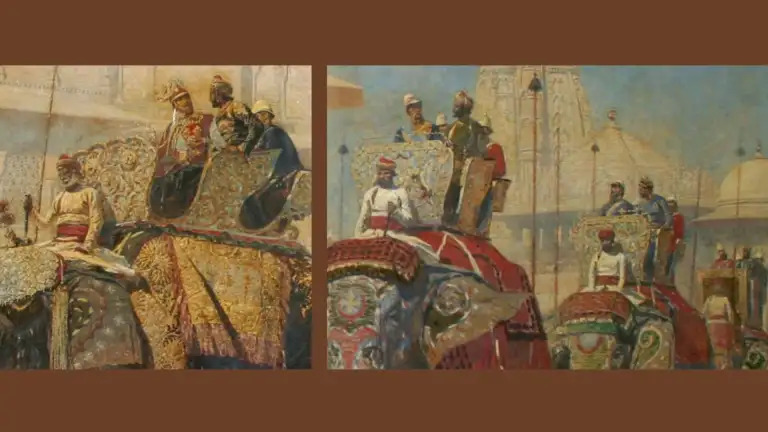
Visiting Jaipur: The nerve centre of the Indian Empire
Jaipur was originally built by Sawai Jai Singh in 1727, when increasing population coupled with water scarcity in Amber necessitated a move to a new capital. By the end of the 19th century, Jaipur had established itself as a remarkable & prosperous city; the vision and agency of its illustrious rulers, industrious merchants and artists added to its glory. It was this Jaipur, a politically significant city of North Western India, that the Prince visited in 1876. Seven military routes, which were the very ‘life lines of the British Empire’ in Western India, traversed through Jaipur.
William Howard Russel, the Prince’s honorary Private Secretary, journaled the impact the city made on the travelling party. The streets, lined with pink houses, stood out to them.
“If I were to say that the houses look as if they were built of strawberry creams streaked in white arabesque, no adequate impression would be produced, simply because one cannot imagine houses of such material. And yet, out of confectionery, I have never beheld any street architecture of this kind.”
WILLIAM HOWARD RUSSEL

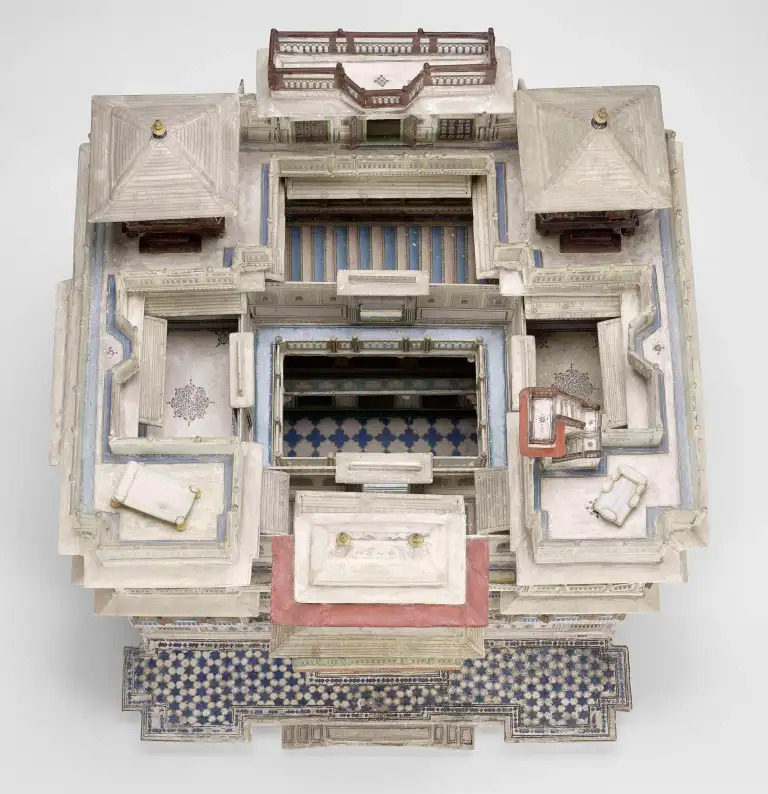
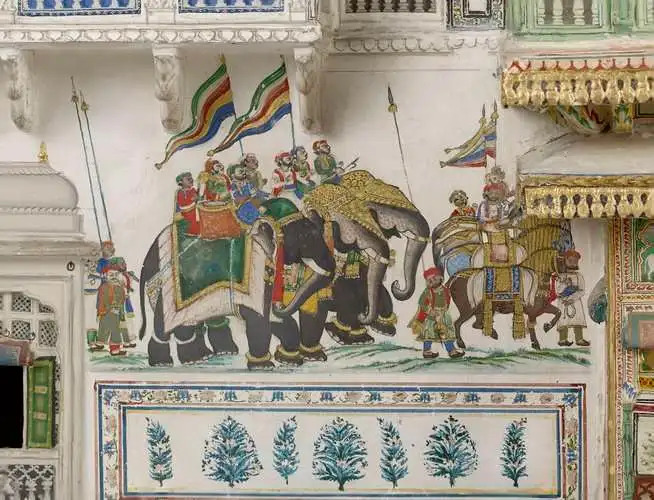
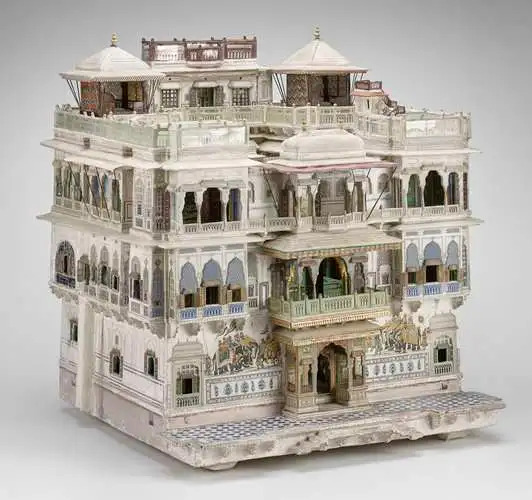
Point to Note: The city was NOT painted pink specifically for the visit of the Prince of Wales. That's just a myth! In reality, the city had always had a geru or terracotta pink colour! The paint was only **refreshed** for the visit.
The maharaja of Jaipur meets the prince
From arranging magnificent processions to showering the prince with gifts, the Maharaja showed great hospitality and generosity. The British prince left the city with a new sword in an enamelled sheath gloriously jewelled, a bag of gold mohurs struck at Jaipur, and large scale photographs, along with the fond memories of his time in Jaipur.

British royal visits to India
An attempt was made to establish connections with the Indian rulers whose lineages had ruled the land for centuries. Most of them were well-liked and popular among their subjects. By building bridges with these rulers, Britain wanted to persuade them to see themselves as “members of an organised Empire”.
In 1877, Queen Victoria, was declared ‘Empress of India’. Prince Albert however, had objected to it: “I could never consent to the word ‘Imperial’ being added to my name”. His understanding of India and its people prompted him to say, “If we continue to regard the heirs of that vast civilisation as conquered dependents, a feeling of alienation will slowly but surely deepen”.
But it seems that his successors did not heed his advice! In 1921, as part of the Non-Cooperation Movement, the Indian National Congress decided to boycott the visit of Prince Edward, who held the same title ‘Prince of Wales’ as Albert had during his visit.
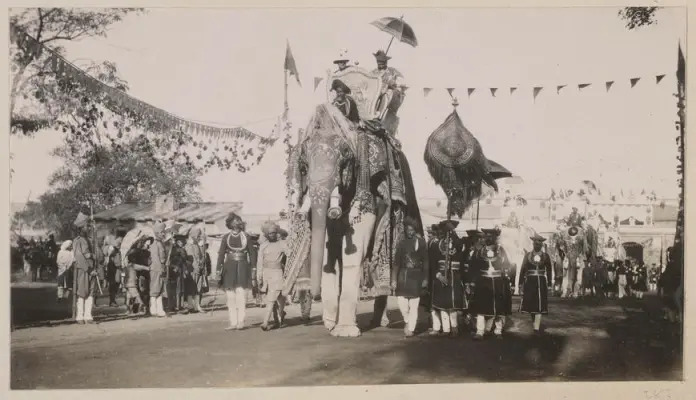
Before Prince Albert’s visit to India, there was also contention in England regarding India’s troublesome finances. But during Prince Albert’s tour, India’s “dazzling accumulation of natural marvels, great traditions, wealth, and historic influence” was on display and assuaged these doubts.
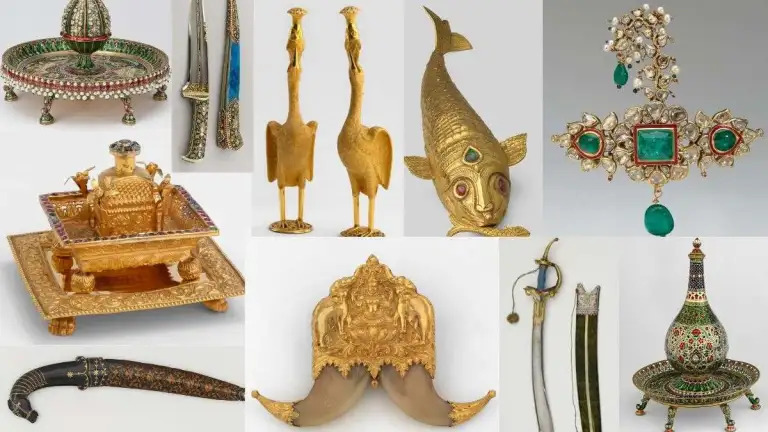
Did You Know: The Albert Hall Museum's foundation stone was laid by Prince Albert himself during his time in Jaipur.
Through hunting expeditions and regal balls, and by inaugurating public works and laying foundation stones for museums, Prince Albert was successful in fostering good relations with the native royals. His visit was a resounding success and the trip was widely covered by the English and Indian press.
Deeper connections: Looking at the painting ‘Jaipur Procession’
Political agents like Sir Alfred Lyall were the key to negotiating with Indian Maharajas. Lyall was sensitive to the concerns of the Jaipur Maharaja and allowed him small wins, but at the same time kept in mind the larger British interests (for example, he let go off an inspection clause in a contract about Salt-trade). What role do paintings such as these play in highlighting or downplaying British interference in domestic politics ?
With the opening of the Suez Canal in 1869, travel time to India decreased substantially. The Prince of Wales’ visit further encouraged English travellers (including the Prince’s younger brother, Alfred, Duke of Edinburgh!) to visit the subcontinent. How do you think this impacted society? What was the impact on India’s industrial crafts?
In his painting, Vasily Vereshchagin also gives attention to the onlookers who stand atop balconies and are waving at the royal guest. He has chosen to highlight the ornate building behind. Another painting of the same event by Sydney P. Hall, who accompanied the Prince on his tour as a ‘Special Artist’, gives a different view.



 souk picks
souk picks